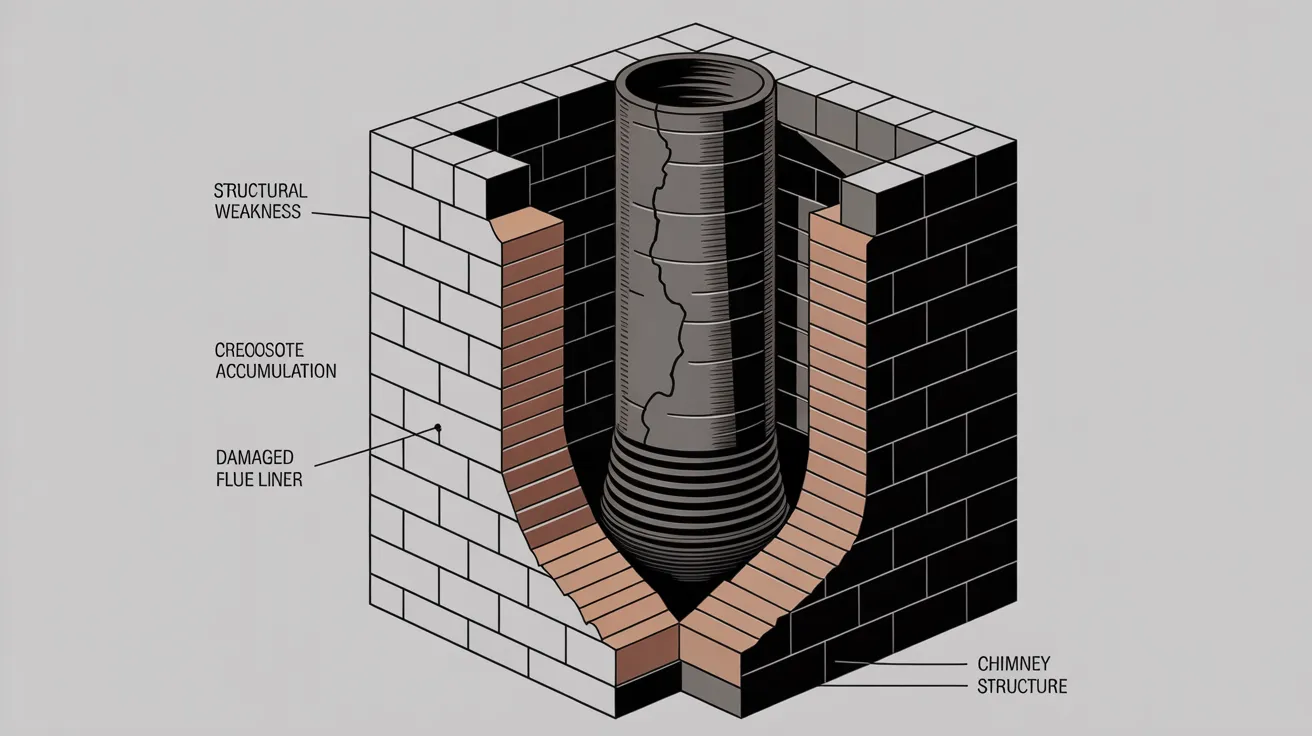For those seeking rapid and professional chimney repair in Seattle, don't overlook red flags including crumbling mortar, water infiltration, or smoke entering your living space. Quick intervention stops fire hazards and expensive structural issues common in Seattle's damp weather. Rely on licensed experts for thorough evaluation, moisture testing, stonework restoration, and water resistance treatment—all following code-compliant methods and safety guidelines. Maintain vigilance; regular inspections and timely maintenance protect your house's functionality and structure. Discover important guidelines and expert guidance to protect your chimney next.

Core Concepts
Warning Signs Your Chimney Requires Repair
Even though your chimney seems solid from the outside, there may be warning signs revealing hidden issues affecting safety and performance. Watch carefully for indoor smoke problems, as this typically indicates problems with your chimney's ventilation system. Heavy soot buildup on interior surfaces or at the fireplace opening suggests poor airflow and increased fire risk. You might notice a strong, persistent odor—this usually suggests harmful deposits are accumulating, restricting proper ventilation. Damaged mortar joints, shifting bricks, or apparent cracks suggest structural deterioration that can worsen quickly if ignored. Through careful observation of these signs, you'll maintain your chimney's safe function and lower the chance of safety issues. Book an expert evaluation at the first sign of trouble.
Typical Chimney Concerns in Seattle Properties
The wet climate of Seattle commonly speeds up chimney deterioration and introduces distinct upkeep problems for homeowners. Dampness causes brick spalling, mortar deterioration, and corrosion of metal components. Without consistent chimney maintenance, creosote and soot build up rapidly due to the area's persistent precipitation and cool temperatures, raising the risk of blockages and fire hazards. You may notice efflorescence—white staining—on your chimney, signaling water infiltration. Broken or absent chimney caps let in precipitation and debris, further compromising structural integrity.
A thorough flue inspection is essential because continuous moisture breeds mold and deteriorates the flue liner, making it unsafe for venting fumes and emissions. Addressing these common issues with scheduled chimney cleaning and comprehensive flue inspection maintains your Seattle home's chimney secure and well-functioning.
The Importance of Timely Chimney Repairs
Tackling chimney problems promptly allows you to prevent costly structural damage that could impact your home's integrity. You'll additionally minimize fire risk by clearing hazards including creosote buildup or masonry cracks. Timely repairs make certain your chimney performs efficiently, boosting both indoor comfort and energy consumption.
Protecting Against Structural Problems
When moisture penetrates into your chimney structure, it speeds up masonry damage, weakens mortar joints, and threatens the chimney's stability. If ignored, minor fissures grow, enabling increased moisture infiltration and causing costly repairs or even structural failure. Routine maintenance helps you spot these issues promptly, eliminating debris that can trap moisture against internal surfaces. Checking and upkeeping your flue lining is essential, as damaged linings expose masonry to damaging compounds and further water infiltration. By taking prompt action, you prevent freeze-thaw cycles from deteriorating masonry and mortar to crumble. Fixing small problems immediately eliminates the need for major reconstruction later. Prioritize professional assessments to ensure your chimney's integrity, safety, and performance for years. Quick response protects your home's structure and tranquility.
Reducing Fire Risk
Should your chimney display structural damage, crumbling mortar, or loose bricks, it may rapidly turn into a significant fire hazard. Compromised areas and weak points enable dangerous heat and embers to escape into adjacent combustible structures, raising the likelihood of a house fire. To preserve optimal chimney safety, you require immediate fixes to address these problems and reestablish the chimney's integrity. Taking care of issues promptly makes certain that flammable creosote cannot collect in hidden spaces, further reducing the risk of fire. Moreover, compromised chimney liners can permit harmful gases to leak into your home, increasing safety concerns. Never delay for minor problems to escalate; quick, professional repair is vital for reliable fire protection and enduring safety in your Seattle home.
Boosting Home Efficiency
Although chimney issues typically seems minor initially, even tiny defects or openings can significantly affect your home's energy effectiveness. When your chimney develops problems, heated or cooled air leaks out, requiring your heating or cooling system to work harder. This not only elevates your utility bills but also puts excessive strain on your climate control unit. Timely chimney fixes, along with regular chimney cleaning, makes certain your fireplace operates at maximum efficiency and avoids unnecessary energy waste.
Before proceeding with a fireplace installation, it's important to address any existing chimney problems. Compromised masonry or defective flue liners may affect the effectiveness of modern fireplaces, decreasing their energy-saving benefits. Through addressing your chimney promptly, you'll preserve a comfortable indoor environment, secure reduced utility bills, and ensure your home's systems perform effectively and securely.
Breaking Down the Chimney Repair Process
You'll start with a thorough assessment and inspection to identify structural problems or safety hazards in your chimney. When problems are discovered, you can select the most appropriate repair solutions, from masonry restoration to chimney liner installation. Every phase focuses on the safety and structural integrity of your home.
Damage Inspection and Evaluation
The first step involves a complete inspection and damage assessment for a proper and reliable chimney repair process. You'll need a qualified professional to inspect your chimney from top to bottom, looking for deterioration, cracks, and loose bricks. Close examination focuses on chimney soot buildup, which can mask deeper issues and create fire hazards. The inspection includes investigating flue blockages, which may stop proper ventilation of dangerous fumes and compromise your home's air quality. Utilizing advanced technology and cameras, they'll investigate hard-to-reach spots, searching for signs of water infiltration, corrosion, or wildlife nests. By documenting all issues of problem areas, you'll gain a clear understanding of what requires attention, ensuring all repairs address fundamental problems—not just surface symptoms.
Guide to Repair Techniques
Once the inspection reveals key concerns, the restoration work can begin with specific remedies intended to restore safety and performance. Professionals begin with complete soot cleaning to eliminate dangerous deposits and improve airflow. When the liner is compromised, they'll recommend liner repair or replacement to prevent hazardous emissions from entering your home and to safeguard masonry from heat damage. Deteriorated masonry need restoration or rebuilding to maintain the chimney's structural integrity. Waterproofing treatments might be implemented to prevent future moisture damage. For extensive deterioration, complete or partial reconstruction might be needed. Every repair technique aims to resolve the root causes, making certain your chimney remains safe, functional, and adherent to Seattle's building codes.
Chimney Leak Detection and Solutions
While chimney leaks typically stay hidden until they cause visible damage, catching problems early is essential to preventing expensive structural damage and health concerns. Watch out for warning signs like water marks on walls or ceilings near your chimney, damp or musty smells, and corroded firebox elements. Specialized chimney leak assessment requires a thorough evaluation of the flashing, crown, and cap to identify water infiltration areas. Technicians employ specialized tools to evaluate concealed moisture and structural issues. Once identified, tested leak repair techniques—such as fixing flashing seals, installing new chimney caps, or applying waterproofing agents—can effectively resolve the situation. By tackling leaks promptly, you'll shield your home from mold growth, deteriorating brickwork, and further moisture problems, maintaining enduring chimney safety and functionality.
Brick Repair and Masonry Services
If you notice cracked, spalling, check here or missing bricks on your chimney, immediate repair work is crucial to maintain structural integrity and prevent hazardous conditions. Deteriorating brick and mortar let water seep in, resulting in swift degradation and potential collapse. It's important to have a skilled technician to assess the extent of damage, ensuring that the proper repair methods are used. During brick replacement, experts carefully remove damaged masonry, select compatible replacements for your chimney, and apply professional-grade mortar for a flawless fix. This detailed process not only enhances aesthetic quality but also protects from further structural issues. Never ignore these problems—addressing masonry problems early will prolong chimney durability and keep your home safe from related hazards.
Specialized Chimney Cap and Crown Maintenance
Functioning as your chimney's main safeguards against water intrusion and animal entry, their condition greatly influences your home's safety and the system's durability. If your chimney cap is damaged, rusted, or absent, water can seep down the flue, causing interior deterioration and likely mold issues. A well-fitted, correctly positioned chimney cap also prevents wildlife, refuse, and rodents from obstructing your venting system. The chimney crown seals the top of your masonry, shielding bricks and mortar from freeze-thaw cycles and erosion. Cracks or spalling in the crown permit moisture to infiltrate, weakening structural integrity. Regular inspections and timely repairs of both the chimney cap and chimney crown ensure you maintain a safe, efficient, and durable chimney system.
Finding the Best Chimney Service Provider
Finding a reputable chimney repair service provider requires detailed assessment of qualifications, safety protocols, and professional knowledge. You must ensure that the business holds proper permits, liability protection, and accreditations from recognized industry bodies. Inquire about their expertise with both chimney cleaning and advanced venting configurations to ensure they can address your system's particular needs. Professionals must adhere to current safety standards, use protective gear, and follow strict guidelines to prevent mishaps or fire risks. Examine their history by verifying recommendations and analyzing customer feedback emphasizing dependability and professionalism. It's also crucial to confirm that they employ industry-approved products and techniques for all work. By emphasizing these elements, you'll ensure your chimney repair work is completed properly, productively, and to the best technical specifications.
Key Maintenance Guidelines for Your Chimney
Arrange periodic chimney inspections to discover potential safety and structural issues early on. Prevent creosote deposits by adhering to proper cleaning schedules and solely using properly seasoned firewood. It's also crucial to use appropriate waterproofing and sealing to protect your chimney from Seattle's regular precipitation.
Regular Chimney Inspections
While many property owners tend to ignore it, scheduling regular chimney inspections is crucial for preserving a safe and efficient fireplace system. You should have your chimney inspected once every year by a qualified expert who can spot structural issues, blockages, or signs of wear. Inspections play a critical role in maintaining chimney safety by revealing hidden problems before they escalate. A comprehensive inspection will additionally assess if chimney cleaning is necessary to eliminate accumulated material or obstacles that could restrict airflow. Certified technicians utilize advanced equipment and imaging devices to assess the entire chimney system, providing a detailed evaluation. By prioritizing regular inspections, you'll defend your home against possible dangers, prolong your chimney's durability, and keep your fireplace operating at peak efficiency.
Creosote Buildup Prevention
Several important preventative maintenance measures can considerably reduce the risk of creosote buildup within your chimney. Only use well-dried hardwood, as it produces less smoke and reduces residue. Confirm that your fireplace damper is fully open during operation to optimize airflow, which promotes efficient combustion and decreases creosote formation. Arrange professional chimney sweeping at least once a year—creosote removal by a certified technician is crucial to prevent dangerous accumulations. Inspect your firebox and flue regularly for early signs of buildup, such as dark, tar-like deposits. Tackle these quickly to avoid a serious fire hazard. Never overfill the firebox or burn unapproved materials, as both can hasten creosote buildup. Following these steps will help keep your chimney safer and more efficient.
Water Protection and Sealing
What makes water infiltration so dangerous for your chimney's stability? When rain infiltration seeps into your masonry, it often results in serious damage, crumbling bricks, and corroding metal parts. Water deteriorates mortar joints and provides perfect conditions for freeze-thaw deterioration, weakening the entire system. To prevent these costly issues, ensure adequate waterproofing and sealing measures.
Start with a thorough examination for openings or fissures that might permit water penetration. Following this, perform a professional-grade sealant application particularly made for chimneys—steer clear of ordinary water repellents, as they may trap moisture. Make sure the sealant is vapor-permeable, enabling the chimney to "breathe" while preventing rain penetration. Periodically reapply sealant every few years to preserve maximum protection. This preventative step prolongs your chimney's life and maintains your home secure.
Booking Your Chimney Inspection and Maintenance
Don't wait for damage to worsen or safety concerns to escalate, schedule your chimney inspection and repair with a certified professional. A certified specialist will inspect the complete setup, identifying potential hazards such as flue complications or urgent cleaning requirements. Never postpone these crucial services—soot buildup or obstructions may lead to fire risks or result in hazardous carbon monoxide seepage into your living space.
Schedule your chimney inspection yearly, or when extreme weather occurs, to ensure your chimney's safety and efficient operation. During the evaluation, professionals employ specialized instruments to assess all chimney components, delivering detailed guidance for any necessary repairs or cleaning. By maintaining regular maintenance, you'll prevent major damage, maintain ideal air quality, and maintain your heating system runs efficiently during the heating months.
Frequently Asked Questions
How Much Does Chimney Repair Usually Cost in Seattle?
As you consider chimney repair in Seattle, plan to pay anywhere from $300 for minor fixes to $3,000 or more for major restoration. You should schedule a chimney inspection first—professionals can spot potential problems and verify safe operation. Chimney cleaning generally runs $150–$350 and might expose repair needs. Always hire certified technicians; they'll use proper tools and approaches to keep your home safe and maintain optimal fireplace performance.
Are Seattle Chimney Repair Permits Necessary?
Think permits are just for massive buildings? Think again! In Seattle, you'll need a permit for nearly all chimney repairs, particularly those that include structural modifications or masonry work. Regular chimney cleaning and safety checks may require adherence to local codes to ensure safety. Make sure to consult Seattle's Department of Construction and Inspections, because avoiding proper documentation could lead to big headaches, unsuccessful assessments, or dangerous situations for your property and loved ones.
Can You Use Your Fireplace During Ongoing Repairs?
Refrain from using your fireplace during ongoing repairs. To maintain fireplace safety, make sure to wait until all repair work is done and thoroughly checked. Using the fireplace during repairs can expose you to fire hazards, toxic fumes, or structural problems. Work closely with your contractor regarding repair scheduling and verify when it's safe to resume use. Putting safety first allows your fireplace to function properly and safely and keeps safe your home and family.
Is Chimney Repair Included in Homeowners Insurance Coverage?
Imagine insurance coverage like an umbrella—it shields you from sudden storms, but not regular deterioration. Homeowners insurance might pay for chimney repair when damage is caused by a protected incident, including storm damage or fire. It won't cover problems due to lack of maintenance or wear and tear. To initiate the claim process, document the damage thoroughly and contact your insurer promptly. Make safety your top priority by having a certified professional inspect your chimney's condition.
How Much Time Does a Regular Chimney Repair Require?
A standard chimney repair generally takes one to three days, depending on the amount of damage found during your chimney inspection. If the masonry restoration needed is minimal, you'll see faster results. Complex repairs, including structural reconstruction, could increase the duration. You should focus on safety by arranging a professional inspection first, as this ensures all ventilation and structural problems are properly evaluated before starting any restoration work.
Final Thoughts
Don't delay until your living room resembles like a scene from Seattle's own version of "Old Faithful"—with water and soot spewing from your ignored chimney. The warning signs are there, you know the risks, so reach for your phone rather than a mop. Prioritize safety and efficiency by booking a professional inspection now. With skilled service and careful attention, you'll keep your home dry, your air clean, and your chimney from starring in its own disaster film.
 Kirk Cameron Then & Now!
Kirk Cameron Then & Now! Sydney Simpson Then & Now!
Sydney Simpson Then & Now! Tiffany Trump Then & Now!
Tiffany Trump Then & Now! Burke Ramsey Then & Now!
Burke Ramsey Then & Now! Morgan Fairchild Then & Now!
Morgan Fairchild Then & Now!